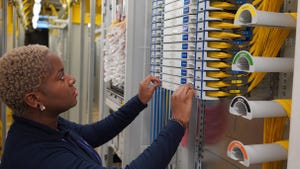Redback's Edge Router Redux
Redback says it's improved its edge router for service providers -- and it has more trash talk for Cisco
May 14, 2002

Redback Networks Inc. (Nasdaq: RBAK) is piping up again about its edge router, saying it's got a new plan to beat Cisco.
Late last week, Redback announced an important upgrade to its edge router, the SmartEdge 800. The improvements make the router more efficient and less likely to cause service provider network outages (see Redback Improves Router). At the same time, the company is turning the anti-Cisco rhetoric up a notch, somewhat of a reversal from a few weeks ago, when in an internal meeting company officials touted a strategy of flying below Cisco Systems Inc.'s (Nasdaq: CSCO) radar (see Redback Rallies Itself).
In sum, experts say that this may be Redback's last chance. The company is the midst of a large transition from its fading DSL business to being a new edge router player, and it's been burning cash in the process. It's quite literally do or die time.
"[Redback] pulled out all the stops in their latest press release… they're desperate," says Erik Keith, a broadband infrastructure analyst at Current Analysis. "They need to gain some kind of market traction soon."
First off: New features. Redback claims its SmartEdge router has a modular operating system that is more resilient than the code running older routers. Even if some part of the SmartEdge 800 router platform crashes -- say, a routing protocol chokes -- the company says the problem won't affect the rest of the platform and traffic will continue to forward traffic.
"Take a look at the recent WorldCom Inc. [Nasdaq: WCOM] outages in their IP network," says Shailesh Shukla, Redback's VP of marketing and business development (see WorldCom's IP Outages: Whodunnit?). "Cisco eventually admitted that its router had some software problems. Hypothetically, if Redback's routers were in that network, customer traffic would not have been affected at all because any software bug would have crashed the control process -- but the [packet] forwarding process would have continued uninterrupted."
Cisco declined to comment, but as Light Reading anticipated, the company did announce some new resiliency software for its routers today (see Cisco Prepping Monster IOS Upgrade and Cisco Intros Globally Resilient IP).
Of course, that a router vendor would attack Cisco is hardly a surprise. "Everyone's going to attack Cisco in this market," says Keith. "When you look at the MPLS VPN deployments out there, Cisco has just about every one in the world. Cisco flat out owns that market."
Other improvements in the SmartEdge 800 router include the ability to provide Generic Routing Encapsulation (GRE)-based virtual private networks (VPNs), a well-hyped service that service providers have been slow to embrace (see VPNs Grow Up and Taking Routing to the Edge).
The improved router also supports thousands of virtual routers within a physical router, the company says. This could be significant because, for a service provider, having an edge router that can be sliced into virtual routers saves it the time required to travel to each customer location in order to set up every leased-line customer with its own router. Because each virtual router runs its own instance of routing protocols, routing tables, buffer memory, and management software, the service provider's customers would, theoretically, continue to feel as though they had their own dedicated physical routers.
This approach to virtual routing is more sophisticated that what's previously been accomplished at the edge, according to Redback. "Today Cisco would like to tell you that they have virtual routers, but the reality is that they have one routing table and there's a security issue when you access the box," says Georges Antoun, a former Cisco executive who now serves as Redback's senior VP of marketing. "We've sliced it so that it actually appears that you have your own router dedicated to you in the service provider's central office."
But do service providers really want to give up the fees for managing routers at a customer location? And will they part with the money they make on reselling routers? Redback suggests that some service providers will embrace virtual routing at the edge because it would make their network simpler. "Managing a router at a customer premises is an expensive revenue stream to maintain when you consider the talent and the man-hours involved," says Shukla.
Redback says that it already has eight edge-router customers and that the product is in 45 trials -- a sign that the industry is ready for its gear. It's noteworthy, too, that other router vendors such as Allegro Networks Inc. and Crescent Networks Inc. are also touting virtual router schemes.
The move to the edge router market hasn't been an easy one. Redback's revenue base remains highly exposed to the DSL sector and the edge router faces intense competition, according to the forthcoming report "Core IP Report" from Light Reading's subscription service Optical Oracle, which includes an analysis of Redback's financials.
"The company deserves credit for stabilizing the revenue base and introducing new product features as planned... [but] until Redback’s fundamentals show clear signs of exiting crisis mode, the risk remains high," the report states.
Redback's emphasis on edge routers has also fueled industry speculation that the company is about to abandon its dormant optical transport business, lay off employees, and concentrate solely on its SMS products and edge routers.
Redback denies that it is edging out of the transport business, though it never dismisses the possibility of staff cuts. "We continue to look at the opportunities in the market, and we've noted that the transport market hasn't been out there for us or anybody else," says Antoun. "That said, we will not kill the platform; it is supporting a lot of customers.
"However, we will continue to look for ways to shift resources to the appropriate opportunities… ahead of us."
Redback says it will have its entire product line on display when it exhibits at Supercomm 2002 in June.
— Phil Harvey, Senior Editor, Light Reading
http://www.lightreading.comFor more information on Supercomm 2002, please visit: SupercommSpecial
Editor's Note: Light Reading is not affiliated with Oracle Corporation.
You May Also Like










